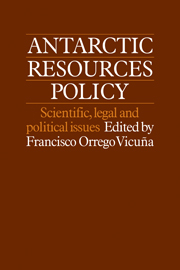Book contents
- Frontmatter
- Contents
- List of contributors
- 1 Antarctic resources policy: an introduction
- Part one The state of Antarctic knowledge and experience
- Part two The policy for the conservation of the living resources of Antarctica
- Part three The policy for the exploration and exploitation of the mineral resources of Antarctica
- 11 Geologic data and its impact on the discussion on a regime for mineral resources
- 12 Basic conditions for the exploration and exploitation of mineral resources in Antarctica: options and precedents
- 13 Oil as a special resource: problems and experiences
- 14 An overview of the problems which should be addressed in the preparation of a regime governing the mineral resources of Antarctica
- 15 The definition of a regime on Antarctic mineral resources: basic options
- 16 Criteria for access to the resources of Antarctica: alternatives, procedure and experience applicable
- Part four Issues on Antarctica and the law of the sea
- Part five The policy for Antarctic cooperation
13 - Oil as a special resource: problems and experiences
Published online by Cambridge University Press: 06 July 2010
- Frontmatter
- Contents
- List of contributors
- 1 Antarctic resources policy: an introduction
- Part one The state of Antarctic knowledge and experience
- Part two The policy for the conservation of the living resources of Antarctica
- Part three The policy for the exploration and exploitation of the mineral resources of Antarctica
- 11 Geologic data and its impact on the discussion on a regime for mineral resources
- 12 Basic conditions for the exploration and exploitation of mineral resources in Antarctica: options and precedents
- 13 Oil as a special resource: problems and experiences
- 14 An overview of the problems which should be addressed in the preparation of a regime governing the mineral resources of Antarctica
- 15 The definition of a regime on Antarctic mineral resources: basic options
- 16 Criteria for access to the resources of Antarctica: alternatives, procedure and experience applicable
- Part four Issues on Antarctica and the law of the sea
- Part five The policy for Antarctic cooperation
Summary
When discussing the subject of oil in Antarctica, three questions must be answered:
(1) Is there oil in this continent?
(2) Are the necessary technologies for exploration and exploitation available?
(3) Under what legal status could these operations be carried out?
The presence of oil in Antarctica
The information presented under this heading comes from a study recently conducted by M. Wannesson of the French Petroleum Institute, who unfortunately was unable to attend the Antarctic Resources Policy Conference.
Antarctica, with an area of 14 million km2, is one and a half times the size of Europe (up to the Urals). More than 95% of its area is covered by an ice cap approximately 2 kilometres thick, on average, which in some places may exceed 4 kilometres in depth. An entire series of geological and geophysical reports have led specialists to ask whether there is oil in Antarctica.
In point of fact, the hydrocarbons found in the course of scientific drilling do not provide the means, even on a local scale, to assess the amount of oil in this continent's subsoil. Moreover, the scarcity of geological information does not currently permit even a qualitative appraisal of Antarctica's overall potential petroleum reserves. Available geological reports only permit a comparison of this continent with regions having a common origin and a comparable geological evolution. These regions on the whole clearly do potentially contain petroleum.
- Type
- Chapter
- Information
- Antarctic Resources PolicyScientific, Legal and Political Issues, pp. 185 - 190Publisher: Cambridge University PressPrint publication year: 1983



